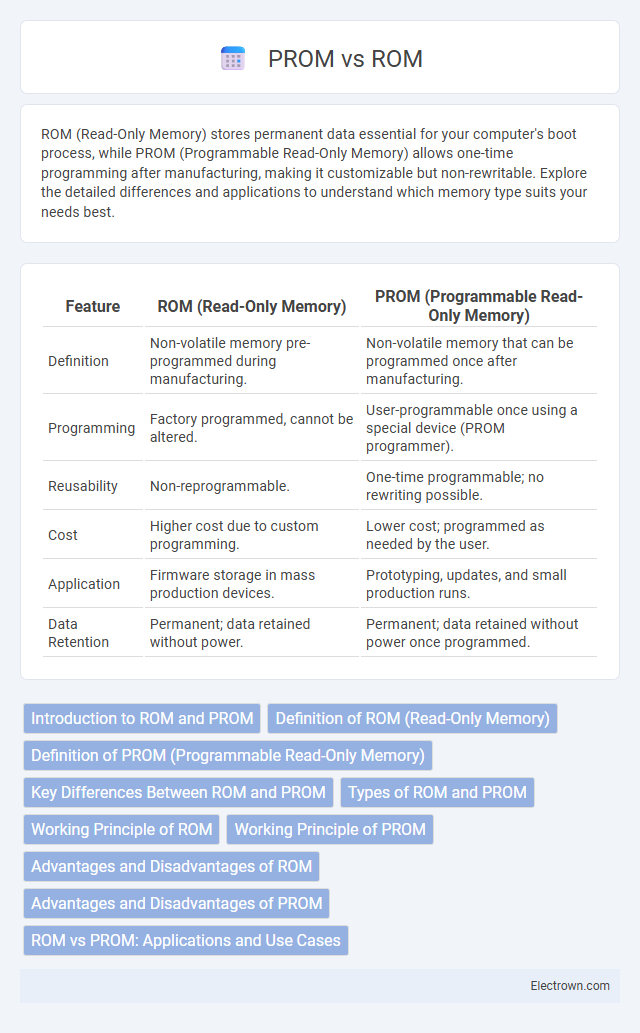ROM (Read-Only Memory) stores permanent data essential for your computer's boot process, while PROM (Programmable Read-Only Memory) allows one-time programming after manufacturing, making it customizable but non-rewritable. Explore the detailed differences and applications to understand which memory type suits your needs best.
Table of Comparison
| Feature | ROM (Read-Only Memory) | PROM (Programmable Read-Only Memory) |
|---|---|---|
| Definition | Non-volatile memory pre-programmed during manufacturing. | Non-volatile memory that can be programmed once after manufacturing. |
| Programming | Factory programmed, cannot be altered. | User-programmable once using a special device (PROM programmer). |
| Reusability | Non-reprogrammable. | One-time programmable; no rewriting possible. |
| Cost | Higher cost due to custom programming. | Lower cost; programmed as needed by the user. |
| Application | Firmware storage in mass production devices. | Prototyping, updates, and small production runs. |
| Data Retention | Permanent; data retained without power. | Permanent; data retained without power once programmed. |
Introduction to ROM and PROM
Read-Only Memory (ROM) is a type of non-volatile memory used for permanent data storage that cannot be easily modified or erased, ensuring stable firmware and system software retention. Programmable Read-Only Memory (PROM) is a subtype of ROM that allows one-time programming by the user after manufacturing, providing customizable and permanent data storage. Both ROM and PROM are essential for embedded systems, firmware, and hardware initialization processes.
Definition of ROM (Read-Only Memory)
ROM (Read-Only Memory) is a non-volatile memory type used to store firmware or permanent data essential for booting and hardware initialization in electronic devices. Unlike RAM, ROM retains data even when power is off, ensuring consistent access to critical instructions. Common ROM variants include masked ROM, PROM, EPROM, and EEPROM, each differing in programmability and reusability.
Definition of PROM (Programmable Read-Only Memory)
PROM (Programmable Read-Only Memory) is a type of non-volatile memory that allows data to be written once after manufacturing, making it customizable for specific applications. Unlike standard ROM, which is pre-programmed, PROM enables Your device's firmware or data to be programmed by burning fuses or altering memory cells through a specialized programmer. This feature makes PROM ideal for devices requiring permanent yet user-defined data storage without further modification.
Key Differences Between ROM and PROM
ROM (Read-Only Memory) is a type of non-volatile memory pre-programmed during manufacturing, containing permanent data that cannot be modified. PROM (Programmable Read-Only Memory) is a type of ROM that allows data to be written once after manufacturing using a special device called a programmer. The key difference lies in programmability: ROM is factory-programmed and unchangeable, while PROM can be programmed once by the user but cannot be erased or reprogrammed afterward.
Types of ROM and PROM
ROM (Read-Only Memory) primarily includes types such as Mask ROM, which is programmed during manufacturing, and Programmable ROM (PROM), which can be written once by the user. PROM itself has variations like EPROM (Erasable Programmable ROM), which can be erased using UV light and reprogrammed, and EEPROM (Electrically Erasable Programmable ROM), which allows electrical erasing and reprogramming without removing the chip. These types differ in reusability, programming flexibility, and erase methods, making them suitable for various firmware storage applications.
Working Principle of ROM
ROM (Read-Only Memory) operates by storing data permanently through integrated circuits programmed during manufacturing, allowing non-volatile retention of information without power. Its working principle relies on fixed memory cells configured to deliver predetermined data when addressed, enabling immediate access to essential firmware. In contrast, PROM (Programmable ROM) can be programmed once after manufacturing via a one-time electrical operation, creating permanent content by selectively fusing connections within the chip.
Working Principle of PROM
PROM (Programmable Read-Only Memory) operates by allowing data to be written only once after manufacturing through a process called "programming," where specific memory cells are permanently altered by blowing fuses or short-circuiting links. Unlike traditional ROM, which comes pre-encoded during fabrication, PROM starts blank and stores information by physically changing the internal structure of its memory cells during programming. Your data remains non-volatile and unchangeable after this one-time programming, making PROM ideal for customized, permanent storage solutions.
Advantages and Disadvantages of ROM
ROM offers non-volatile memory storage, ensuring data retention even when the power is off, which makes it ideal for firmware and system boot processes. It has fast read speeds and is cost-effective for mass production, but its contents are permanently written during manufacturing, limiting flexibility and updates. The inability to modify data after programming restricts adaptability and requires replacement or additional components for changes.
Advantages and Disadvantages of PROM
PROM (Programmable Read-Only Memory) offers the advantage of being writable once after manufacturing, allowing customization for specific applications, which enhances flexibility compared to standard ROM. However, PROM's key disadvantage is its permanent nature after programming, meaning errors cannot be corrected and the memory cannot be reused. Your choice of PROM suits scenarios where one-time customization is valuable, but consider alternatives like EEPROM for rewritable needs.
ROM vs PROM: Applications and Use Cases
ROM is widely used in embedded systems, firmware storage, and gaming consoles where permanent, unalterable data storage is essential for device functionality. PROM is favored in development environments and manufacturing processes that require one-time programmable memory for custom firmware or calibration data tailored to specific hardware configurations. Your choice between ROM and PROM depends on whether you need fixed data storage or programmable flexibility during production.
ROM vs PROM Infographic

 electrown.com
electrown.com